Sprained Ankle: Rehabilitation Exercises
Overview
In the case of a minor sprain, rehabilitation (rehab) exercises begin soon after the injury with walking. You can try wearing hiking boots or other high-top, lace-up shoes for support. But don't force your foot into a boot if it hurts or causes discomfort.
Stretch daily, especially before and after physical activities to prevent reinjury. Even after your ankle feels better, do rehab exercises several times a week to keep it strong.
The timing and type of rehab exercises may vary according to your doctor's or physical therapist's preferences. You'll probably do the following types of exercise.
- Range-of-motion exercises. These help you move the joint as far as you can in every direction that it moves.
- Stretching exercises. They help keep your Achilles tendon (heel cord) flexible while your ankle heals.
- Strengthening exercises. These strengthen the muscles so they help support your ankle.
- Balance and control exercises. They help your foot and ankle respond to activities. This can help prevent reinjury.
How to do rehabilitation exercises for an ankle sprain
Here are some examples of typical rehabilitation (rehab) exercises for an ankle sprain. Start each exercise slowly and use your pain level to guide you in doing them. Ease off the exercise if you have more than mild pain.
Keep in mind that the timing and type of rehab exercises recommended for you may vary with your doctor's or physical therapist's preferences.
Range-of-motion exercises
These types of exercises begin right after your injury. Try doing these exercises and then putting ice on your ankle. Do this up to 5 times a day. These are easy to do while you are at a desk or using a TV or other electronic device.
Stretching exercises
Start exercises to stretch your Achilles tendon as soon as you can do so without pain. The Achilles tendon connects the calf muscles on the back of the lower leg to the bone at the base of the heel.
Strengthening exercises
Talk to your doctor or physical therapist about the timing of strengthening exercises for the ankle. You can most likely start them when you are able to stand without increased pain or swelling.
Balance and control exercises
You can usually start balance and control exercises when you are able to stand without pain. But talk to your doctor or physical therapist about the exact timing. Also, don't try these exercises if you could not have done them easily before your injury. If you think you would have felt unsteady doing these exercises when your ankle was healthy, you are at risk of falling if you try them with an injured ankle.
Range-of-motion exercises
Ankle alphabet
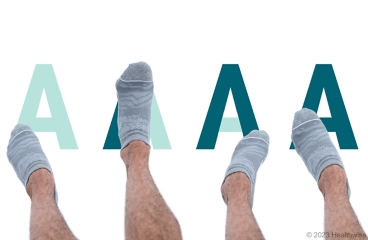
- Sit in a chair with your feet flat on the floor. (You can also do this exercise lying on your back with your affected leg propped up on a pillow).
- Lift the heel of your affected foot off the floor, and slowly trace the letters of the alphabet.
- It's a good idea to repeat these steps with your other foot.
Side-to-side knee swing
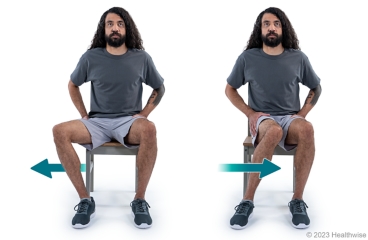
- Sit in a chair with your affected foot flat on the floor.
- Slowly move your knee from side to side. Keep your foot pressed flat.
- Continue this exercise for 2 to 3 minutes.
- It's a good idea to repeat these steps with your other foot.
Towel scrunch
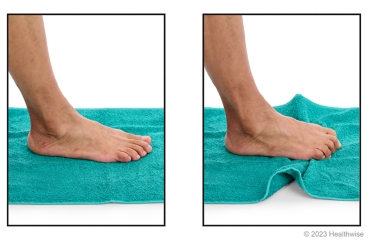
- Sit in a chair, and place your affected foot on a towel on a hard floor (not a floor with carpet).
- Scrunch the towel toward you with your toes. Then use your toes to push the towel back into place.
- Repeat 8 to 12 times.
- It's a good idea to repeat these steps with your other foot.
Make this exercise more challenging by placing a weighted object, such as a soup can, on the other end of the towel.
Stretching exercises
Calf stretch (seated, knee straight)
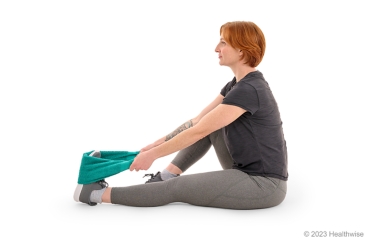
- Sit on the floor with your affected leg straight and resting on the floor.
- Place a towel around your affected foot.
- Hold one end of the towel in each hand.
- Pull back gently with the towel so that you feel a stretch in your calf.
- Hold the position for 15 to 30 seconds.
- Repeat 2 to 4 times.
- It's a good idea to repeat these steps with your other leg.
Calf stretch (back knee straight)
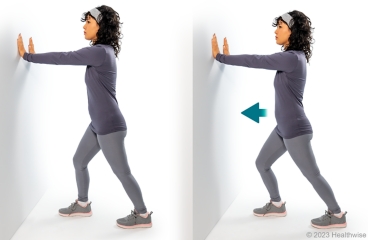
- Stand facing a wall with your hands on the wall. You can also do this with your hands on the back of a chair, a counter, or a tree.
- Put one leg about a step behind your other leg, with your toes pointing forward.
- Keeping your back leg straight and your back heel on the floor, bend your front knee and gently bring your hip and chest toward the wall until you feel a stretch in the calf of your back leg.
- Hold the stretch for 15 to 30 seconds.
- Repeat 2 to 4 times for each leg.
Strengthening exercises
Ankle eversion
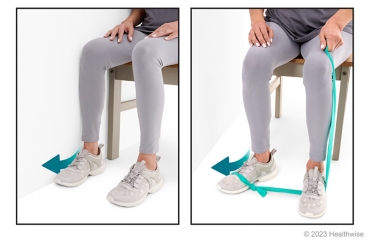
- Sit in a chair with your affected foot flat on the floor and next to a wall or a piece of furniture that doesn't move.
- Push your foot outward against the wall or piece of furniture.
- Hold for about 6 seconds, and then relax.
- Repeat 8 to 12 times.
- It's a good idea to turn the chair around and repeat these steps with your other foot.
After you feel comfortable with this, try using an exercise band for resistance instead of a wall. Tie a loop in one end of an exercise band, or hold both ends of the band in one hand. Put the loop around the outside of your affected foot and then step on the band with your other foot. Push your affected foot out to the side against the band, and then count to 10 as you slowly bring your foot back to the middle. Repeat 8 to 12 times. Then it's a good idea to repeat the steps with your other foot.
Ankle opposition (isometric)
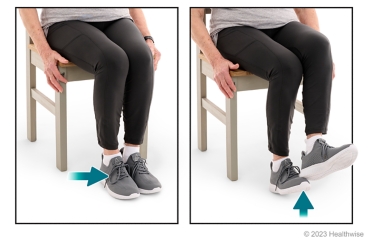
- Sit up straight. Put your feet together, flat on the floor.
- Press your affected foot inward against your other foot.
- Then place the heel of your other foot on top of the affected foot. Push up with your affected foot against the heel of your other foot. Your muscles will tighten, but your affected foot should not move up.
- Hold for about 6 seconds, and then relax.
- Repeat 8 to 12 times.
- It's a good idea to repeat these steps with your other foot.
- Hold for about 6 seconds, and then relax.
- Repeat 8 to 12 times.
- It's a good idea to repeat these steps with your other foot.
Balance and control exercise
Single-leg balance
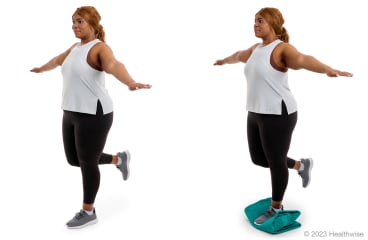
- Stand on a flat surface with your arms stretched out to your sides like you are making the letter "T." Then lift your good leg off the floor, bending it at the knee. If you are not steady, use one hand to hold on to a chair, counter, or wall.
- Standing on your affected leg, keep that knee straight. Try to balance on that leg for up to 30 seconds, and then rest.
- Repeat 8 to 12 times.
- It's a good idea to repeat these steps with your other leg.
When you can balance on your affected leg for 30 seconds with your eyes open, try to balance on it with your eyes closed.
When you can do this exercise with your eyes closed for 30 seconds with ease and no pain, try standing on a pillow or piece of foam.
Credits
Current as of: July 24, 2025
Author: Ignite Healthwise, LLC Staff
Clinical Review Board
All Ignite Healthwise, LLC education is reviewed by a team that includes physicians, nurses, advanced practitioners, registered dieticians, and other healthcare professionals.
Current as of: July 24, 2025
Author: Ignite Healthwise, LLC Staff
Clinical Review Board
All Ignite Healthwise, LLC education is reviewed by a team that includes physicians, nurses, advanced practitioners, registered dieticians, and other healthcare professionals.

